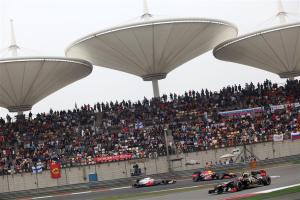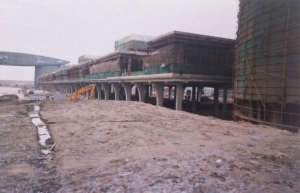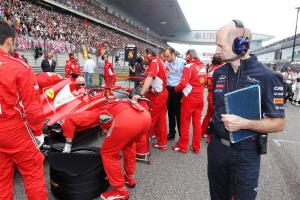I was going through some old photos this morning. Yes. Real photos. Real actual printed photographs. How very retro.
Amongst some very random and slightly embarrassing windows into my youth, I found a lovely little selection taken 10 years ago, on my very first trip to Shanghai, for Formula 1 Magazine. And given that we’re flying off to China early next week, I thought I’d share them with you.
The Yu Garden, Shanghai was one of the earliest places we visited. We spent a long time in the area and I’m sad to say that I haven’t been back in many years. The problem is that Shanghai itself is so far from the track and so over the past 5 years I have stopped staying in the town as more and more of us have moved to Jiading. Back in 2003, however, Jiading barely even existed.
This is me and Cristiano da Matta, who was racing for Toyota at the time. He was to be our cover star for the magazine and we spent a lot of time together that week, caught up in traffic, getting lost en route to a track that didn’t exist, eating weird and wonderful food, buying fake watches, discussing Led Zeppelin, The Rolling Stones and The Beatles… and getting tremendously annoyed with a photographer and artistic director whose combined efforts were so poor, Bernie requested the cover be photoshopped. And so we ended up with one of the most mocked front covers of any motorsport magazine ever, in which poor Cris had his head superimposed onto a stock photo of someone on a rickshaw. This photo was taken shortly after Cris had bought a knock off Bolex, and then been most upset that I’d bartered a Mont Plonk pen and a Jag Heuer for the same price.
This is all that existed of the grandstands at the track. These are the two that enclose the braking zone at the end of the long back straight, which now have the famous discs adorning the top of them. As you can see, we are absolutely in the middle of nowhere. It took us almost half a day to find the track. Jiading itself was nothing. A dirt track with a few industrial units. Seeing how fast this district has developed over the past decade has been possibly the biggest lesson in what an F1 track can bring to an area, but also in just how fast the Chinese economy has grown in that time. This is how it looks now…
The start-finish straight. We talk almost every year about how bumby the China track is and about the boggy land on which it was built. Hopefully these photos will give you an idea of just how deep into the ground they had to dig to find something resembling solid earth. It was still awfully soft, and that is why the track’s bumpiness continues to evolve year on year.
Again… here’s how it looks now.
And these are the team buildings… the one thing that sticks in my mind the most about this photo was the large piles of human faeces all over the place. There were no portloos, you see, so the poor workers just had to go wherever they could. It was a wasteland. In numerous ways.
Jiading itself is an undiscovered gem. A historic little place with beautiful old architecture and a Confuscious temple. But 10 years ago it was not the bustling, ever expanding city it is becoming today. It was a small industrial town. Finding these old photos again has given me much to reflect upon. I’d forgotten just what a desolate location the track was placed in. When I say there was nothing there, I mean there was nothing there… just an endless expanse of flat nothingness. I remember falling asleep in the car and waking up an hour later and still being no further towards finding the location of the track. Nobody had a clue that a track was even being built, or what for. Now it is a source of great pride.
Perhaps it is important to remember that when we see the grandstands fail to fill, grands prix in the modern era aren’t just about putting bums on seats. In the case of China, its been about breathing new life into an area and giving investors a reason to put their money into it.
The small desolate town of Jiading I saw in 2003 and the bustling metropolis I’m flying to in 2013, are proof that it works.















So they spent millions upon millions to build a track totally for foreigners and a city to act as a huge backdrop. Shaking my head at the thought that that is progress. It’s all FAKE , but as long as the show looks good who cares right ?
No that’s not the point at all. The track has acted as a magnet, if you like. It has drawn attention to the area and has thus brought investment to it. How is that fake? It has invigorated the local economy and jobs market. What was a town is now a quickly growing city. It’s actually quite amazing.
As a local Shanghainese I have witnessed such changes happening in my hometown but hardly tried to look back to 10 years ago to compare it with what we have now and realise what great change it is. So thank you for taking me back as well 🙂
The Shanghai International Curcuit plays an important part in the local racing fans community, that’s for sure. Personally I feel the promo of the curcuit is getting better and better. In my point of view it’s not only a show for foreigners, or just a landmark to attract investors, it plays it’s role as a curcuit.
Unfortunately, the “invigorated local economy” comes at a cost. The state run/designed economy causes the loss of life, homes, and involves no liberty for the citizens of the area. Jiading wasn’t a wasteland where there was nothing prior to this fabulous F1 track and bustling metropolis now exists, it was farm land with thousands of families that were forcibly relocated in order to provide this “progress”. I have witnessed it in Beijing in 2005 prior to the Olympics as well as areas of Shanghai in the name of economic growth. I would have loved to see photos of the Jiading area 2 years prior to your first visit for a true before and after to go along with your story. I do not ascribe to the “fake” take on this growth, however the images portrayed by China about their progress hide the underlying damage that is done to individuals and families and human rights in general. I think it is better to describe this progress as manufactured, and that manufacturing is directed and controlled by a small few in a land of billions.
Don’t get me wrong, I love China and have been there as a tourist and a businessman many times and enjoy the people, culture, history, and amazing growth that they have seen over the past 20 years. I just have a hard time with many of the methods through which this progress is obtained. As an American, I see many similarities in our cultures, particularly in an economic sense, with the enormous exception that in the US everybody has the same rights and liberties, rather than the chosen few that have the power and influence to do anything that they want, as in China. It may take longer to conceive and develop and F1 track in the US (take Austin as an example), but at least I can sleep at night knowing that no one was forced out because the track was in the works. Can’t say the same for the China track.
BTW, you should go back to the Yu garden and update your photos on this trip. It looks the same, only busier. Ate some fantastic dim sum there last summer….
These are the stories that other journalist lack to talk about . For someone like myself i enjoy the nut’s and bolts to things , I am waiting for the next interview with Ferrari the tension from that last race must be unreal with Alonso , not making that pit stop on which i believe if he had stopped he could of one that race . I want to know who’s decision it was for him (ALONSO ) Not to pit or for him to keep going on . I believe will has it in him to get these answers . Keep up the great work and stay safe .
Great seeing the before, and after photos! kind of what is happening right now (on a different scale) in Austin Tx.
Thanks for the memories. This is my first year in 3 that I did not make it to Shanghai. Enjoy!!
Progress always comes with a tinge of melancholy. I miss Shanghai for the very reasons you’ve given: not enough time now to go the extra mile…
Just why the GP2 Series doesn’t race there?
Hey Will,
Good job as usual this weekend in China.
Wanted to talk about the tyres. No, I’m not going to whine and complain about them, I’m actually going to say something very positive that most have failed to see.
Yes, we’re all aware they degrade too much, that Pirelli has gone too far, etc… but after analyzing the first 3 races of the season I saw something very positive about them.
It’s no coincidence that 8 out of the 9 podium finishers in the first 3 races are world champions. These tyres are highlighting the difference between the really good drivers and the rest in capital letters. An F1 champion is supposed to consistently squeeze every ounce of performance out of the car regardless the conditions, and in that aspect, the Pirelli’s have been stellar.
Just take a look at the mediocre performances from Massa, Perez, Gutierrez, Grosjean, Pic, Chilton, Van der Garde, Maldonado, etc. They are looking average at best.
On the other hand, take a look at the drivers who have been performing brilliantly since the championship started: Alonso, Raikkonen, Hamilton, Vettel, Button, Hulkenberg, Bianchi…
Cheers!